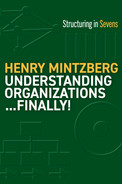Preface
In 1979 I published The Structuring of Organizations: A Synthesis of the Research, 512 pages of small type. I like it best of all my books, for its flow and cohesion. It has also been my most successful book, especially in its shortened version, Structure in Fives, released in 1983, with 312 pages of larger type.
Here I revise and update that book, not as a synthesis of the research so much as a synthesis of my lifetime of experiences with organizations. In 1979 the published research required synthesis: there was a great deal of literature, but all over the place. These books pulled it together. But the need remains, in practice as well as education, for a wider understanding of organizations, which are central to almost everything we do.
So here, on the foundation of Structure in Fives, I pull together a half century of experience—my own and whatever else I found—as Structuring in Sevens, for the purposes of Understanding Organizations . . . Finally!
Hermits can stop reading here. So can pedants: this book has fewer references, and I make no apologies for the many that are older. Good insights, like good wine, survive the test of time. So do good stories, of which you will read many old, as well as new.
I may be better known as a management theorist, but, more fundamentally, I am an organization theorist. Almost all my working life has been devoted to understanding these strange beasts. If a good chess player can go from one match to the next, understanding the board quickly, I feel that, with so many years observing, advising, and experiencing organizations, as soon as I enter one, I get a visceral sense of it—the culture, the condition, almost the smell of the place. Imagine how much experience, how many stories, can be accumulated in half a century. I heard once about a science-fiction character who went mad because every time he passed grass being cut, he could hear it screaming. I’m not going mad, but when I am near an organization, I can hear the screams—whether of delight or despair.
Books are written by individuals, but with the support of organizations (like most everything else these days). Thank you especially McGill University, for always being so supportive, likewise our current dean Yolande Chan, and Berrett-Koehler, for always being so engaging, especially Neal Maillet as a delightful partner on this book, as was Steve Piersanti on all the others.
The support of other individuals has been substantial, and heartfelt: Dulcie Naimer, who contributed so much, personally and materially; Santa Balanca-Rodrigues, who, after a quarter century, becomes a better assistant by the day; Jeremiah Lee, who set this book on course early; Jeff Kulick, who takes manuscript review to rare heights; Alex Anderson, whose meticulousness combined well with my lack of it; Charles Marful, who saved me from messing up Chapters 2–6; Lars Groth, whose detailed feedback helped to clarify several confusions; Saku Mantere, whose help on Chapter 20 was invaluable; the excellent work of David Peattie and Ashley Ingram in production, Amy Smith Bell for her careful editing, Susan Mintzberg for her unofficial editing, Dave Dudley for great diagrams, and for other specific help, Hanieh Mohammadi, Karl Moore, and P. D. Jose.
